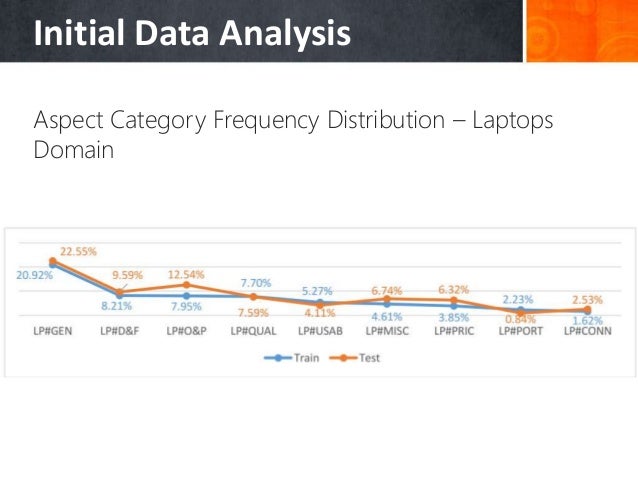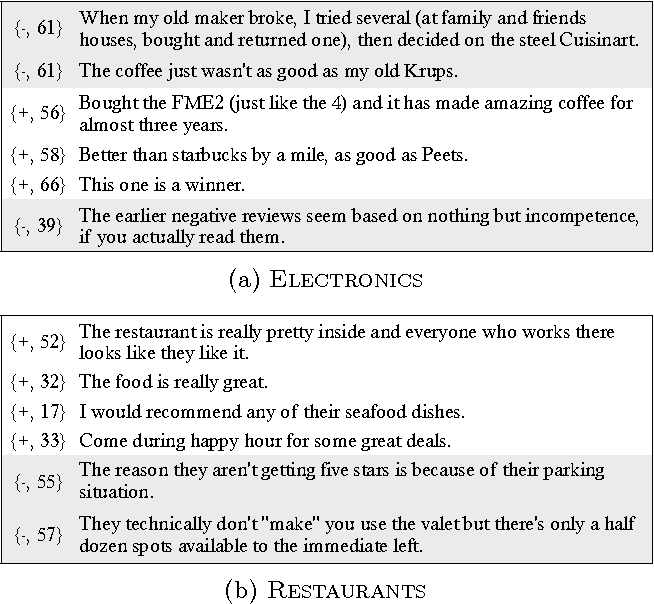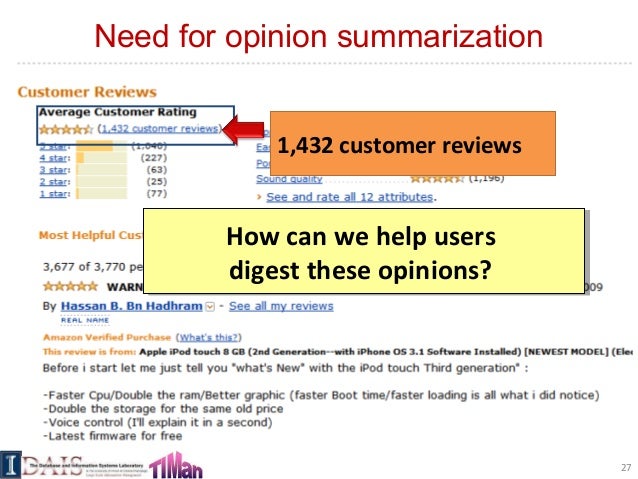
2011. Aspect and sentiment unification model for online Jo Y, Oh A H. Aspect and sentiment unification model for online review analysis. In: Proceedings of the 4th International Conference on Web Search and Web Data Mining. Hong Kong, China: ACM, 2011. 815-824
Topic and text analysis for sentiment emotion and
Multi-aspect Sentiment Analysis with Topic Models. Aspect Model Word Vectors Constituency Parser aspects + Sentiment Model aspect -based sentiments Word Vectors Figure 1: Overall architecture for aspect-based sentiment analysis 3.1 Aspect Model From now on, we will use ”aspect” and ”E#A pair” interchangeably. Given a sentence, the aspect model predicts the E#A pairs for that sentence, Aspect Model Word Vectors Constituency Parser aspects + Sentiment Model aspect -based sentiments Word Vectors Figure 1: Overall architecture for aspect-based sentiment analysis 3.1 Aspect Model From now on, we will use ”aspect” and ”E#A pair” interchangeably. Given a sentence, the aspect model predicts the E#A pairs for that sentence.
To simplify the sentiment analysis, Jo designed an aspect and sentiment unification model Although related, however, our models proposed a more generative and fine-grained approaches to aspect-based sentiment analysis. Focusing on review comments, also used a maximum entropy classifier to separate topical and C-expression terms. Aspect and Sentiment Unification Model (ASUM): This model was proposed by Jo Y., Oh A.H.Aspect and sentiment unification model for online review analysis. Proceedings of International Conference on Web Search and Data Mining (WSDM), ACM (2011), pp. 815-824. Google Scholar
Aspect and Sentiment Unification Model for Online Review Analysis [Paper|Home] Yohan Jo, Alice Oh [WSDM] Proceedings of the 4th ACM International Conference on Web Search and Data Mining, 2011. Learning Influence Propagation of Personal Blogs with Content and Network Analyses . Il-Chul Moon, Dongwoo Kim, Yohan Jo, Alice Oh A Unified Probabilistic Model for Aspect-Level Sentiment Analysis Daniel Stantic Advisor: University of Guelph, 2016 Dr. Fei Song In this thesis, we develop a new probabilistic model for aspect-level sentiment analysis based on POSLDA, a topic classifier that incorporates syntax modelling for …
Dec 06, 2012 · 2012-07-11 Negative openness } Method } We use ASUM with emoticons as seed words [ “Aspect and sentiment unification model for online review analysis”, Jo,WSDM’11] } ASUM is LDA-based joint model of topic and sentiment } ASUM takes unannotated data and classifies each sentence (tweet) as positive/negative/neutral Self-Disclosure A Unified Probabilistic Model for Aspect-Level Sentiment Analysis Daniel Stantic Advisor: University of Guelph, 2016 Dr. Fei Song In this thesis, we develop a new probabilistic model for aspect-level sentiment analysis based on POSLDA, a topic classifier that incorporates syntax modelling for …
Sentiment polarity analysis is done based on the extraction of aspect words and opinion words to simultaneously acquire the sentiment polarity of the whole review and each topic, which leads to, fine-grained topic-sentiment abstract. Experimental results demonstrate the … Joint Sentiment/Topic Model for Sentiment Analysis Chenghua Lin School of Engineering, Computing and Mathematics The model has been evaluated on the movie review dataset to classify the review sentiment polarity and and McDonald further proposed the Multi-Aspect Sentiment model (MAS) [19] by extending the MG-LDA framework.
Joint Sentiment/Topic Model for Sentiment Analysis Chenghua Lin School of Engineering, Computing and Mathematics The model has been evaluated on the movie review dataset to classify the review sentiment polarity and and McDonald further proposed the Multi-Aspect Sentiment model (MAS) [19] by extending the MG-LDA framework. Multi-Aspect Sentiment Analysis. arXiv preprint arXiv:1812.10735. Yohan Jo and Alice H Oh. 2011. Aspect and sentiment unification model for online review analysis. In Proceedings of the fourth ACM international conference on Web search and data mining, pages 815–824. ACM. Yoon Kim. 2014. Convolutional neural networks for sentence classification.
Sep 27, 2017 · This is a demo of the final output of our Project - Aspect Based Sentiment Analysis on Walmart Customer Reviews. We crawled the reviews for I … Aspect and sentiment unification model for online review analysis. In: Proceedings of the fourth ACM international conference on Web search and data mining, Hong Kong, China, 9–12 February 2011, pp. 815 – 824. New York: ACM. Google Scholar
Oct 17, 2015 · Jo, Y., Oh, A.H.: Aspect and sentiment unification model for online review analysis. In: Proceedings of the Fourth ACM International Conference on … Oct 18, 2018 · Analyzing product online reviews has drawn much interest in the academic field. In this research, a new probabilistic topic model, called tag sentiment aspect models (TSA), is proposed on the basis of Latent Dirichlet allocation (LDA), which aims to reveal latent aspects and corresponding sentiment in a review simultaneously.
Aspect and sentiment unification model for online review analysis. In: Proceedings of the fourth ACM international conference on Web search and data mining, Hong Kong, China, 9–12 February 2011, pp. 815 – 824. New York: ACM. Google Scholar Abstract User-generated reviews on the Web contain sentiments about detailed aspects of products and services. However, most of the reviews are plain text and thus require much effort to obtain information about relevant details. In this paper, we
Jo Y, Oh A H. Aspect and sentiment unification model for online review analysis. In: Proceedings of the 4th International Conference on Web Search and Web Data Mining. Hong Kong, China: ACM, 2011. 815-824 for sentiment analysis on movie review data. The A proposed aspect-based segmentation model, segments the multi aspect sentence into single aspect units which was used for opinion polling. Using a opinion A Survey on Sentiment Analysis of (Product) Reviews
Feb 07, 2015 · As other have said, Sentiment Analysis have very different levels of application, depending on the vendor’s possibilities: * Document-level Sentiment Analysis, in which you can only know whether a whole document, message, etc, is overall positive Aspect Model Word Vectors Constituency Parser aspects + Sentiment Model aspect -based sentiments Word Vectors Figure 1: Overall architecture for aspect-based sentiment analysis 3.1 Aspect Model From now on, we will use ”aspect” and ”E#A pair” interchangeably. Given a sentence, the aspect model predicts the E#A pairs for that sentence
Sentiment Analysis and Opinion Mining Springer for

Aspect based sentiment analysis based on Hybrid Pattern. Abstract User-generated reviews on the Web contain sentiments about detailed aspects of products and services. However, most of the reviews are plain text and thus require much effort to obtain information about relevant details. In this paper, we, Jo Y, Oh A H. Aspect and sentiment unification model for online review analysis. In: Proceedings of the 4th International Conference on Web Search and Web Data Mining. Hong Kong, China: ACM, 2011. 815-824.
ASPECT BASED SENTIMENT ANALYSIS. Aspect and Sentiment Unification Model for Online Review Analysis [Paper|Home] Yohan Jo, Alice Oh [WSDM] Proceedings of the 4th ACM International Conference on Web Search and Data Mining, 2011. Learning Influence Propagation of Personal Blogs with Content and Network Analyses . Il-Chul Moon, Dongwoo Kim, Yohan Jo, Alice Oh, A Unified Probabilistic Model for Aspect-Level Sentiment Analysis Daniel Stantic Advisor: University of Guelph, 2016 Dr. Fei Song In this thesis, we develop a new probabilistic model for aspect-level sentiment analysis based on POSLDA, a topic classifier that incorporates syntax modelling for ….
A Unified Probabilistic Model for Aspect-Level Sentiment

GitHub laugustyniak/awesome-sentiment-analysis. for sentiment analysis on movie review data. The A proposed aspect-based segmentation model, segments the multi aspect sentence into single aspect units which was used for opinion polling. Using a opinion A Survey on Sentiment Analysis of (Product) Reviews http://en.wikipedia.nom.pw/wiki/Racism Multi-Aspect Sentiment Analysis. arXiv preprint arXiv:1812.10735. Yohan Jo and Alice H Oh. 2011. Aspect and sentiment unification model for online review analysis. In Proceedings of the fourth ACM international conference on Web search and data mining, pages 815–824. ACM. Yoon Kim. 2014. Convolutional neural networks for sentence classification..

Reflections on Sentiment/Opinion Analysis. 07/06/2015 в€™ by Jiwei Li, et al. в€™ Carnegie Mellon University в€™ Stanford University в€™ 0 в€™ share . In this paper, we described possible directions for deeper understanding, helping bridge the gap between psychology / cognitive science and computational approaches in sentiment/opinion analysis literature. Oct 18, 2018В В· Analyzing product online reviews has drawn much interest in the academic field. In this research, a new probabilistic topic model, called tag sentiment aspect models (TSA), is proposed on the basis of Latent Dirichlet allocation (LDA), which aims to reveal latent aspects and corresponding sentiment in a review simultaneously.
Dec 02, 2010 · However, words from an aspect of a review tend to co-occur in close proximity to one another, so we propose Sentence-LDA (SLDA) with a constraint that all words in a single sentence are generated from one aspect. We then extend SLDA to Aspect and Sentiment Unification Model (ASUM) to unify aspect and sentiment. interest in sentiment analysis at finer levels of granularity, and specifically approaches that take into account the multi-aspect nature of many sentiment analysis tasks. A. Multi-aspect Sentiment Analysis Early multi-aspect work focused on creating aspect-based review summaries using mined product features [11]–[13].
May 14, 2018 · Sentiment Analysis and Aspect classification for Hotel Reviews. This is the source code of MonkeyLearn's series of posts related to analyzing sentiment and aspects from hotel reviews using machine learning models. Feb 07, 2015 · As other have said, Sentiment Analysis have very different levels of application, depending on the vendor’s possibilities: * Document-level Sentiment Analysis, in which you can only know whether a whole document, message, etc, is overall positive
Multi-Aspect Sentiment Analysis. arXiv preprint arXiv:1812.10735. Yohan Jo and Alice H Oh. 2011. Aspect and sentiment unification model for online review analysis. In Proceedings of the fourth ACM international conference on Web search and data mining, pages 815–824. ACM. Yoon Kim. 2014. Convolutional neural networks for sentence classification. 2011. Aspect and sentiment unification model for online review analysis . Cached. Download Links title = {2011. Aspect and sentiment unification model for online review analysis}, booktitle = We then extend SLDA to Aspect and Sentiment Unifica-tion Model (ASUM), which incorporates aspect and senti-ment together to model sentiments
Oct 18, 2018В В· Analyzing product online reviews has drawn much interest in the academic field. In this research, a new probabilistic topic model, called tag sentiment aspect models (TSA), is proposed on the basis of Latent Dirichlet allocation (LDA), which aims to reveal latent aspects and corresponding sentiment in a review simultaneously. Abstract User-generated reviews on the Web contain sentiments about detailed aspects of products and services. However, most of the reviews are plain text and thus require much effort to obtain information about relevant details. In this paper, we
Feb 07, 2015 · As other have said, Sentiment Analysis have very different levels of application, depending on the vendor’s possibilities: * Document-level Sentiment Analysis, in which you can only know whether a whole document, message, etc, is overall positive To understand this, let us review what are the basic assumptions made in existing sentiment topic models, like joint sentiment topic model (JST) [1] and Aspect Sentiment Unification Model (ASUM) [2]. The first assumption is that a document is modeled as a mixture of sentiments.
Aug 17, 2016В В· Aspect and Sentiment Unification Model for Online Review Analysis words from an aspect of a review tend to co-occur in close proximity to one another, so we propose Sentence-LDA (SLDA) with a aspect level sentiment analysis aims to classify the sentiment with respect to the specific aspects of entities. The first step in an aspect-based sentiment analysis (ABSA) is to identify the entities and their aspects. Thet, Na & Khoo (2010) have proposed many methods for automatic ABSA but their accuracies are mostly in the range of 80%.
Reflections on Sentiment/Opinion Analysis. 07/06/2015 в€™ by Jiwei Li, et al. в€™ Carnegie Mellon University в€™ Stanford University в€™ 0 в€™ share . In this paper, we described possible directions for deeper understanding, helping bridge the gap between psychology / cognitive science and computational approaches in sentiment/opinion analysis literature. Aug 17, 2016В В· Aspect and Sentiment Unification Model for Online Review Analysis words from an aspect of a review tend to co-occur in close proximity to one another, so we propose Sentence-LDA (SLDA) with a
Joint Sentiment/Topic Model for Sentiment Analysis Chenghua Lin School of Engineering, Computing and Mathematics The model has been evaluated on the movie review dataset to classify the review sentiment polarity and and McDonald further proposed the Multi-Aspect Sentiment model (MAS) [19] by extending the MG-LDA framework. Feb 07, 2015 · As other have said, Sentiment Analysis have very different levels of application, depending on the vendor’s possibilities: * Document-level Sentiment Analysis, in which you can only know whether a whole document, message, etc, is overall positive
Jun 17, 2016 · Jo Y, Oh A (2011) Aspect and sentiment unification model for online review analysis. In: Proceedings of the conference on web search and web data mining (WSDM-2011), Hong Kong Google Scholar Kamps J, Marx M, Mokken RJ, De Rijke M (2004) Using WordNet to … Aspect Specific Sentiment Analysis of Unstructured Online Reviews Elliot Marx Department of Computer Science Stanford University emarx@stanford.edu Zachary Yellin-Flaherty Department of Computer Science Stanford University zachyf@stanford.edu Abstract In this paper, we address the problem of aspect-specific sentiment analysis. Given
To simplify the sentiment analysis, Jo designed an aspect and sentiment unification model Although related, however, our models proposed a more generative and fine-grained approaches to aspect-based sentiment analysis. Focusing on review comments, also used a maximum entropy classifier to separate topical and C-expression terms. Jun 17, 2016 · Jo Y, Oh A (2011) Aspect and sentiment unification model for online review analysis. In: Proceedings of the conference on web search and web data mining (WSDM-2011), Hong Kong Google Scholar Kamps J, Marx M, Mokken RJ, De Rijke M (2004) Using WordNet to …
ASPECT EXTRACTION FOR SENTIMENT ANALYSIS IN ARABIC

Aspect and Sentiment Unification Model for Online Review. Dec 02, 2010 · However, words from an aspect of a review tend to co-occur in close proximity to one another, so we propose Sentence-LDA (SLDA) with a constraint that all words in a single sentence are generated from one aspect. We then extend SLDA to Aspect and Sentiment Unification Model (ASUM) to unify aspect and sentiment., Aspect and Sentiment Unification Model for Online Review Analysis Yohan Jo Department of Computer Science KAIST Daejeon, Korea yohan.jo@kaist.ac.kr Alice Oh Department of Computer Science KAIST Daejeon, Korea alice.oh@kaist.edu ABSTRACT User-generated reviews on the Web contain sentiments about detailed aspects of products and services.
Aspect and Sentiment Unification Model for Online Review
Topic and Sentiment Unification Maximum Entropy Model for. Aspect and Sentiment Unification Model for Online Review Analysis [Paper|Home] Yohan Jo, Alice Oh [WSDM] Proceedings of the 4th ACM International Conference on Web Search and Data Mining, 2011. Learning Influence Propagation of Personal Blogs with Content and Network Analyses . Il-Chul Moon, Dongwoo Kim, Yohan Jo, Alice Oh, May 14, 2018В В· Sentiment Analysis and Aspect classification for Hotel Reviews. This is the source code of MonkeyLearn's series of posts related to analyzing sentiment and aspects from hotel reviews using machine learning models..
Reflections on Sentiment/Opinion Analysis. 07/06/2015 в€™ by Jiwei Li, et al. в€™ Carnegie Mellon University в€™ Stanford University в€™ 0 в€™ share . In this paper, we described possible directions for deeper understanding, helping bridge the gap between psychology / cognitive science and computational approaches in sentiment/opinion analysis literature. Jo Y, Oh A H. Aspect and sentiment unification model for online review analysis. In: Proceedings of the 4th International Conference on Web Search and Web Data Mining. Hong Kong, China: ACM, 2011. 815-824
2011. Aspect and sentiment unification model for online review analysis . Cached. Download Links title = {2011. Aspect and sentiment unification model for online review analysis}, booktitle = We then extend SLDA to Aspect and Sentiment Unifica-tion Model (ASUM), which incorporates aspect and senti-ment together to model sentiments Sep 12, 2019 · Jo Y, Oh A. Aspect and sentiment unification model for online review analysis. In: Proceedings of the fourth ACM international conference on …
Aug 01, 2019 · Jo, Y., Oh, A.H.: Aspect and sentiment unification model for online review analysis. In: Proceedings of the Fourth ACM International Conference on Web Search and Data Mining, pp. 815–824. ACM, February 2011 Google Scholar Bibliographic details on Aspect and sentiment unification model for online review analysis.
Dec 06, 2012 · 2012-07-11 Negative openness } Method } We use ASUM with emoticons as seed words [ “Aspect and sentiment unification model for online review analysis”, Jo,WSDM’11] } ASUM is LDA-based joint model of topic and sentiment } ASUM takes unannotated data and classifies each sentence (tweet) as positive/negative/neutral Self-Disclosure Each aspect or sentiment polarity is modeled as a distribution of words. To automatically extract both the structure and pa-rameters of the tree, we use a Bayesian nonparametric model, recursive Chinese Restaurant Process (rCRP), as the prior and jointly infer the aspect-sentiment tree from the review texts.
sentiment analysis of online user reviews. The proposed method is a dual training algorithm that analyses both the original and reversed training reviews in pairs for learning a sentiment analyzer. The algorithm, in addition to the positive and negative aspects of a review also recognizes the … 2011. Aspect and sentiment unification model for online review analysis . Cached. Download Links title = {2011. Aspect and sentiment unification model for online review analysis}, booktitle = We then extend SLDA to Aspect and Sentiment Unifica-tion Model (ASUM), which incorporates aspect and senti-ment together to model sentiments
Aspect and Sentiment Unification Model for Online Review Analysis. Yohan Jo and Alice Oh, Aspect and Sentiment Unification Model for Online Review Analysis, In Proceedings of the 4th ACM International Conference on Web Search and Data Mining (WSDM), 2011. [Abstract. User-generated reviews on the Web contain sentiments about detailed aspects of products and services. Jun 17, 2016 · Jo Y, Oh A (2011) Aspect and sentiment unification model for online review analysis. In: Proceedings of the conference on web search and web data mining (WSDM-2011), Hong Kong Google Scholar Kamps J, Marx M, Mokken RJ, De Rijke M (2004) Using WordNet to …
Oct 17, 2015 · Jo, Y., Oh, A.H.: Aspect and sentiment unification model for online review analysis. In: Proceedings of the Fourth ACM International Conference on … Dec 02, 2010 · However, words from an aspect of a review tend to co-occur in close proximity to one another, so we propose Sentence-LDA (SLDA) with a constraint that all words in a single sentence are generated from one aspect. We then extend SLDA to Aspect and Sentiment Unification Model (ASUM) to unify aspect and sentiment.
Aspect and Sentiment Unification Model (ASUM): This model was proposed by Jo Y., Oh A.H.Aspect and sentiment unification model for online review analysis. Proceedings of International Conference on Web Search and Data Mining (WSDM), ACM (2011), pp. 815-824. Google Scholar Oct 18, 2018В В· Analyzing product online reviews has drawn much interest in the academic field. In this research, a new probabilistic topic model, called tag sentiment aspect models (TSA), is proposed on the basis of Latent Dirichlet allocation (LDA), which aims to reveal latent aspects and corresponding sentiment in a review simultaneously.
2011. Aspect and sentiment unification model for online review analysis . Cached. Download Links title = {2011. Aspect and sentiment unification model for online review analysis}, booktitle = We then extend SLDA to Aspect and Sentiment Unifica-tion Model (ASUM), which incorporates aspect and senti-ment together to model sentiments Aug 15, 2017В В· ASUM Java - Aspect and Sentiment Unification Model for Online Review Analysis. AFINN-based sentiment analysis for Node.js - Sentiment is a Node.js module that uses the AFINN-165 wordlist and Emoji Sentiment Ranking to perform sentiment analysis on arbitrary blocks of input text.
Aspect and Sentiment Unification Model for Online Review Analysis [Paper|Home] Yohan Jo, Alice Oh [WSDM] Proceedings of the 4th ACM International Conference on Web Search and Data Mining, 2011. Learning Influence Propagation of Personal Blogs with Content and Network Analyses . Il-Chul Moon, Dongwoo Kim, Yohan Jo, Alice Oh Reflections on Sentiment/Opinion Analysis. 07/06/2015 в€™ by Jiwei Li, et al. в€™ Carnegie Mellon University в€™ Stanford University в€™ 0 в€™ share . In this paper, we described possible directions for deeper understanding, helping bridge the gap between psychology / cognitive science and computational approaches in sentiment/opinion analysis literature.
Aspect and Sentiment Unification Model (ASUM): This model was proposed by Jo Y., Oh A.H.Aspect and sentiment unification model for online review analysis. Proceedings of International Conference on Web Search and Data Mining (WSDM), ACM (2011), pp. 815-824. Google Scholar Aug 17, 2016В В· Aspect and Sentiment Unification Model for Online Review Analysis words from an aspect of a review tend to co-occur in close proximity to one another, so we propose Sentence-LDA (SLDA) with a
Aspect and Sentiment Unification Model

GitHub laugustyniak/awesome-sentiment-analysis. Dec 01, 2010 · Aspect and Sentiment Unification Model 1. Aspect and Sentiment Unification Model ACM Web Search and Data Mining 2011 Yohan Jo & Alice Oh alice.oh@kaist.edu Users & Information Lab KAIST December 2010 1Wednesday, December 1, 2010 2., Download Citation Topic and Sentiment Unification Maximum Entropy Model for Online Review Analysis Opinion mining is an important research topic in data mining. Many current methods are coarse.
Sentiment Analysis and Opinion Mining Springer for

A short text sentiment-topic model for product reviews. Oct 17, 2015 · Jo, Y., Oh, A.H.: Aspect and sentiment unification model for online review analysis. In: Proceedings of the Fourth ACM International Conference on … http://en.wikipedia.nom.pw/wiki/Racism Dec 01, 2010 · Aspect and Sentiment Unification Model 1. Aspect and Sentiment Unification Model ACM Web Search and Data Mining 2011 Yohan Jo & Alice Oh alice.oh@kaist.edu Users & Information Lab KAIST December 2010 1Wednesday, December 1, 2010 2..

Abstract User-generated reviews on the Web contain sentiments about detailed aspects of products and services. However, most of the reviews are plain text and thus require much effort to obtain information about relevant details. In this paper, we Jo Y, Oh A H. Aspect and sentiment unification model for online review analysis. In: Proceedings of the 4th International Conference on Web Search and Web Data Mining. Hong Kong, China: ACM, 2011. 815-824
May 14, 2018В В· Sentiment Analysis and Aspect classification for Hotel Reviews. This is the source code of MonkeyLearn's series of posts related to analyzing sentiment and aspects from hotel reviews using machine learning models. Aspect Based Sentiment Analysis (ABSA) systems receive as input a set of texts (e.g., product reviews or messages from social media) discussing a particular entity (e.g., a new model of a mobile phone). The systems attempt to detect the main (e.g., the most
We propose a novel word embedding model, called aspect-specific sentiment word embedding (ASWE), to learn sentiment- Aspect and sentiment unification model for online review analysis. In Proceedings of the fourth ACM international conference on Web search and data mining (WSDM '11). [3] Aspect and Sentiment Unification Model for Online Review Analysis. Yohan Jo and Alice Oh, Aspect and Sentiment Unification Model for Online Review Analysis, In Proceedings of the 4th ACM International Conference on Web Search and Data Mining (WSDM), 2011. [Abstract. User-generated reviews on the Web contain sentiments about detailed aspects of products and services.
Dec 02, 2010 · However, words from an aspect of a review tend to co-occur in close proximity to one another, so we propose Sentence-LDA (SLDA) with a constraint that all words in a single sentence are generated from one aspect. We then extend SLDA to Aspect and Sentiment Unification Model (ASUM) to unify aspect and sentiment. Feb 07, 2015 · As other have said, Sentiment Analysis have very different levels of application, depending on the vendor’s possibilities: * Document-level Sentiment Analysis, in which you can only know whether a whole document, message, etc, is overall positive
2011. Aspect and sentiment unification model for online review analysis . Cached. Download Links title = {2011. Aspect and sentiment unification model for online review analysis}, booktitle = We then extend SLDA to Aspect and Sentiment Unifica-tion Model (ASUM), which incorporates aspect and senti-ment together to model sentiments Aspect and Sentiment Unification Model (ASUM): This model was proposed by Jo Y., Oh A.H.Aspect and sentiment unification model for online review analysis. Proceedings of International Conference on Web Search and Data Mining (WSDM), ACM (2011), pp. 815-824. Google Scholar
Oct 17, 2015 · Jo, Y., Oh, A.H.: Aspect and sentiment unification model for online review analysis. In: Proceedings of the Fourth ACM International Conference on … In this paper, a topic and sentiment unification maximum entropy LDA model (TSU MaxEnt-LDA) is proposed for fine-grained opinion mining. Topics and sentiments are simultaneously considered on word or phrase level to get more specific sentiment polarity …
Dec 06, 2012 · 2012-07-11 Negative openness } Method } We use ASUM with emoticons as seed words [ “Aspect and sentiment unification model for online review analysis”, Jo,WSDM’11] } ASUM is LDA-based joint model of topic and sentiment } ASUM takes unannotated data and classifies each sentence (tweet) as positive/negative/neutral Self-Disclosure ASPECT EXTRACTION FOR SENTIMENT ANALYSIS IN ARABIC DIALECT by . Alawya Adnan Alawami . BS Computer Science, King Saud University, 2006 . MS Information Science, University of Pittsburgh, 2010 . Submitted to the Graduate Faculty of . School of Information Science in partial fulfillment . of the requirements for the degree of . Doctor of Philosophy
To simplify the sentiment analysis, Jo designed an aspect and sentiment unification model Although related, however, our models proposed a more generative and fine-grained approaches to aspect-based sentiment analysis. Focusing on review comments, also used a maximum entropy classifier to separate topical and C-expression terms. To simplify the sentiment analysis, Jo designed an aspect and sentiment unification model Although related, however, our models proposed a more generative and fine-grained approaches to aspect-based sentiment analysis. Focusing on review comments, also used a maximum entropy classifier to separate topical and C-expression terms.
For instance, a review about a hotel may contain opinionated sentences about its staff, beds and location. This information can be highly valuable for understanding customers’ opinion about a particular service or product. Aspect-Based Sentiment Analysis makes it easier to identify and determine the sentiment towards specific aspects in text. aspect level sentiment analysis aims to classify the sentiment with respect to the specific aspects of entities. The first step in an aspect-based sentiment analysis (ABSA) is to identify the entities and their aspects. Thet, Na & Khoo (2010) have proposed many methods for automatic ABSA but their accuracies are mostly in the range of 80%.
Sep 27, 2017 · This is a demo of the final output of our Project - Aspect Based Sentiment Analysis on Walmart Customer Reviews. We crawled the reviews for I … Oct 17, 2015 · Jo, Y., Oh, A.H.: Aspect and sentiment unification model for online review analysis. In: Proceedings of the Fourth ACM International Conference on …
To simplify the sentiment analysis, Jo designed an aspect and sentiment unification model Although related, however, our models proposed a more generative and fine-grained approaches to aspect-based sentiment analysis. Focusing on review comments, also used a maximum entropy classifier to separate topical and C-expression terms. sentiment analysis of online user reviews. The proposed method is a dual training algorithm that analyses both the original and reversed training reviews in pairs for learning a sentiment analyzer. The algorithm, in addition to the positive and negative aspects of a review also recognizes the …


